Диспетчер учетных данных Windows (Credential Manager) позволяет безопасно хранить учетные записи и пароля для доступа к сетевым ресурсам, веб сайтам и приложениям. Благодаря сохраненным в Credential Manager паролям вы можете подключаться без ввода пароля к сетевым ресурсам, которые поддерживаются проверку подлинности Windows (NTLM или Kerbersos), аутентификацию по сертификату, или базовую проверку подлинности.
Содержание:
- Используем диспетчер учетных данных Windows для хранения паролей
- Управление сохраненными учетными данными Windows из командной строки
- Доступ к менеджеру учетных данных Windows из PowerShell
Используем диспетчер учетных данных Windows для хранения паролей
Диспетчер учетных данных встроен в Windows и позволяет безопасно хранить три типа учетных данных:
- Учетные данные Windows (Windows Credentials) — учетные данные доступа к ресурсам, которые поддерживаются Windows аутентификацию (NTLM или Kerbersos). Это могут быть данные для подключения сетевых дисков или общим SMB папкам, NAS устройствам, сохраненные пароли для RDP подключений, пароли к сайтам, поддерживающих проверку подлинности Windows и т.д;
- Учетные данные сертификатов (Certificate-Based Credentials) – используются для доступа к ресурсам с помощью сертификатов (из секции Personal в Certificate Manager);
- Общие учетные данные (Generic Credentials) – хранит учетные данные для доступа к сторонним приложениям, совместимым с Credential Manager и поддерживающим Basic аутентификацию;
- Учетные данные для интернета (Web Credentials) – сохранённые пароли в браузерах Edge и Internet Explorer, приложениях Microsoft (MS Office, Teams, Outlook, Skype и т.д).
Например, если при доступе к сетевой папке вы включите опцию “Сохранить пароль”, то введенный вами пароли будет сохранен в Credential Manager.
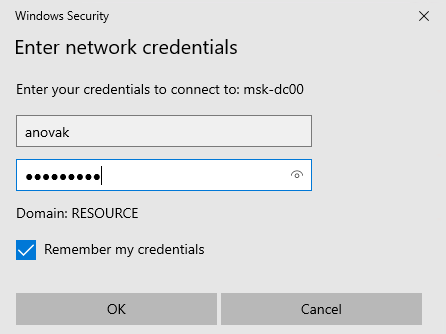
Аналогично пароль для подключения к удаленному RDP/RDS серверу сохраняется в клиенте Remote Desktop Connection (mstsc.exe).
Открыть диспетчер учетных данных в Windows можно:
- из классической панели управления (Control Panel\User Accounts\Credential Manager, Панель управления -> Учетные записи пользователей -> Диспетчер учетных данных);
- изкоманднойстроки:
control /name Microsoft.CredentialManager
На скриншоте видно, что в Credential Manager хранятся два пароля, которые мы сохранили ранее.
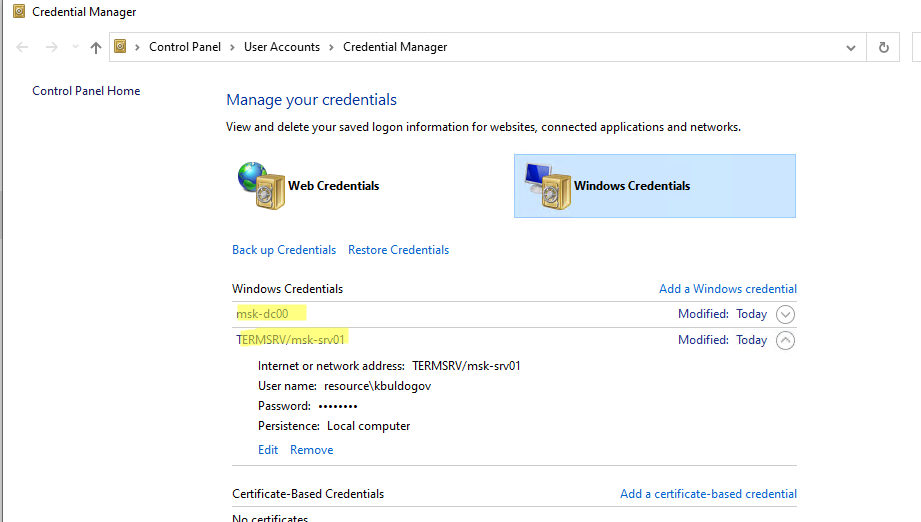
Сохраненный пароль для RDP подключения сохраняется в формате
TERMSRV\hostname
.
Здесь вы можете добавить сохранённый пароль, отредактировать (просмотреть сохраненный пароль в открытом виде из графического интерфейса нельзя) или удалить любую из записей.
Для управления сохраненными паролями можно использовать классический диалоговый интерфейс Stored User Names and Password. Для его запуска выполните команду:
rundll32.exe keymgr.dll,KRShowKeyMgr
Здесь вы также можете управлять сохраненными учетными данными, а также выполнить резервное копирование и восстановление записей в Credential Manager (можно использовать для переноса базы Credential Manager на другой компьютер).
Управление сохраненными учетными данными Windows из командной строки
Вы можете добавить удалить и вывести сохраненные учетные данных в Credentil Manager из командной строки с помощью утилиты cmdkey.
Добавить в диспетчер учетные данные для доступа к серверу FS01:
cmdkey /add:FS01 /user:kbuldogov /pass:Passw0rdd1
Если нужно сохранить доменную учетную запись:
cmdkey /add:fs01.winitpro.local /user:[email protected] /pass:Passw0rdd1
Сохранить учетные данные для доступа к RDP/RDS серверу:
cmdkey /generic:termsrv/MSKRDS1 /user:kbuldogov /pass:Passw0rdd1
Вывести список сохраненных учетных данных:
cmdkey /list
Вывести список хранимых учетных данных для указанного компьютера:
cmdkey /list:fs01.winitpro.local
Удалить ранее сохраненные учетные данные:
cmdkey /delete:FS01
Удалить из Credential Manager все сохраненные пароли для RDP доступа:
For /F "tokens=1,2 delims= " %G in ('cmdkey /list ^| findstr "target=TERMSRV"') do cmdkey /delete %H
Полностью очистить пароли в Credential Manager:
for /F "tokens=1,2 delims= " %G in ('cmdkey /list ^| findstr Target') do cmdkey /delete %H

Также для управления сохраненными учетными данными можно использовать утилиту vaultcmd.Вывести список сохраненных учетных данных типа Windows Credentials:
vaultcmd /listcreds:"Windows Credentials"
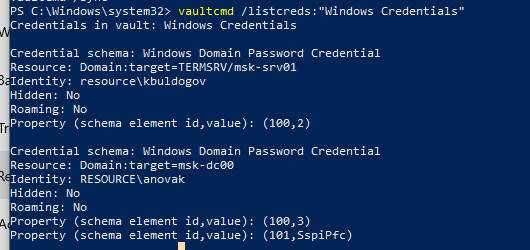
Все сохраненные пароли хранятся в защищенном хранилище Windows Vault. Путь к хранилищу можно получить с помощью команды:
vaultcmd /list

По умолчанию это
%userprofile%\AppData\Local\Microsoft\Vault
. Ключ шифрования хранится в файле Policy.vpol. Клю шифровани используется для рашировки паролей в файлах .vcrd.
Для работы Credential Manager должна быть запущена служба VaultSvc:
Get-Service VaultSvc
Если служба отключена, при попытке получить доступ к Credential Manager появится ошибка:
Credential Manager Error The Credential Manager Service is not running. You can start the service manually using the Services snap-in or restart your computer to start the service. Error code: 0x800706B5 Error Message: The interface is unknown.
Если вы хотите заблокировать пользователям возможность сохранения сетевых паролей в Credential Manager, нужно включить параметр Network access: Do not allow storage of passwords and credentials for network authentication в разделе GPO Computer Configuration -> Windows Settings -> Security Settings -> Local Policies -> Security Options.
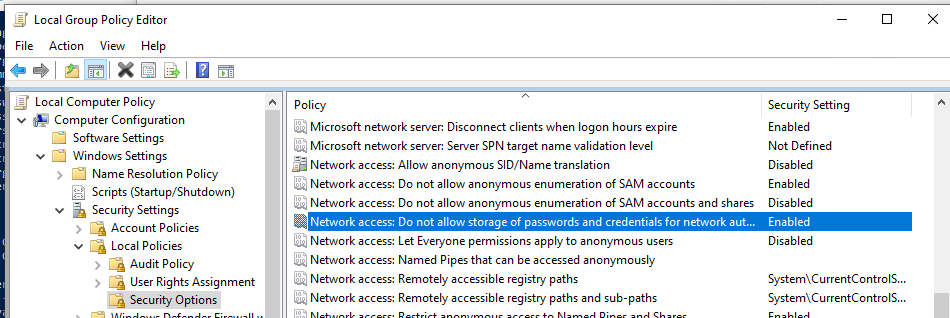
Теперь, если пользователь попытается сохранить пароль в хранилище, появится ошибка:
Credential Manager Error Unable to save credentials. To save credentials in this vault, check your computer configuration. Error code: 0x80070520 Error Message: A specified logon session does not exist. It may already have been terminated.
Доступ к менеджеру учетных данных Windows из PowerShell
В Windows нет встроенных командлетов для обращения к хранилищу PasswordVault из PowerShell. Но вы можете использовать модуль CredentialManager из галереи PowerShell.
Установите модуль:
Install-Module CredentialManager

В модуле всего 4 командлета:
- Get-StoredCredential – получить учетные данные из хранилища Windows Vault;
- Get-StrongPassword – сгенерировать случайный пароль;
- New-StoredCredential – добавить учетные данные в хранилище;
- Remove-StoredCredential – удалить учетные данные.
Чтобы добавить новые учетные данные в хранилище CredentialManager, выполните команду:
New-StoredCredential -Target 'contoso' -Type Generic -UserName '[email protected]' -Password '123qwe' -Persist 'LocalMachine'

Проверить, есть в хранилище сохраненные данные:
Get-StoredCredential -Target contoso
С помощью командлета Get-StoredCredential вы можете вывести сохраненный пароль, хранящийся в диспетчере учетных данных в отрытом виде.
Выведите список сохраненных учетных данных:
cmdkey.exe /list
Скопируйте значение Target для объекта, пароль которого вы хотите извлечь и вставьте его в следующую команду:
$cred = Get-StoredCredential -Target LegacyGeneric:target=termsrv/MSKRD2S1 [System.Runtime.InteropServices.Marshal]::PtrToStringAuto([System.Runtime.InteropServices.Marshal]::SecureStringToBSTR($cred.Password))
Команда выведет сохраненный пароль в открытом виде.
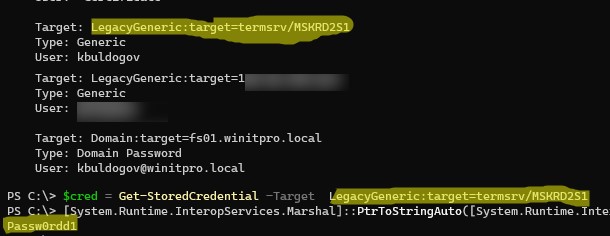
Также для получения сохраненных паролей из credman в открытом виде можно использовать утилиты типа Mimikatz (смотри пример).
Сохраненные пароли из Credential Manager можно использовать в ваших скриптах PowerShell. Например, в следующем примере я получаю сохраненные имя и пароль в виде объекта PSCredential и подключаюсь с ними к Exchange Online из PowerShell:
$psCred = Get-StoredCredential -Target "Contoso"
Connect-MSolService -Credential $psCred
Также вы можете использовать Get-StoredCredential для безопасного получения сохранённых учетных данных в заданиях планировщика.
Также обратите внимание на модуль PowerShell Secret Management, который можно использовать для безопасного хранения паролей в Windows (поддерживает различные хранилища паролей: KeePass, LastPass, HashiCorp Vault, Azure Key Vault, Bitwarden.
Чтобы удалить сохраненные учетные данные из Windows Vault, выполните:
Remove-StoredCredential -Target Contoso
Applies ToWindows 11 Windows 10
Диспетчер учетных данных позволяет просматривать и удалять сохраненные учетные данные для веб-сайтов, приложений и сетей.
-
Чтобы открыть диспетчер учетных данных, введите диспетчер учетных данных в поле поиска на панели задач и выберите панель управления диспетчера учетных данных.
-
Выберите Учетные данные веб-сайтов или Учетные данные Windows для доступа к учетным данным, которыми вы хотите управлять.
Нужна дополнительная помощь?
Нужны дополнительные параметры?
Изучите преимущества подписки, просмотрите учебные курсы, узнайте, как защитить свое устройство и т. д.
Время на прочтение2 мин
Количество просмотров113K
Утилита mimikatz, позволяющая извлекать учётные данные Windows из LSA в открытом виде, существует с 2012 года, однако помимо хорошо освещённого функционала восстановления паролей из памяти работающей ОС у неё есть ещё одна довольно интересная возможность. Далее я приведу пошаговую инструкцию, как при помощи нехитрых действий извлечь учётные данные из файла hiberfil.sys.
Подготовка
Для осуществления задуманного нам понадобятся следующие утилиты:
- Debugging Tools for Windows;
- Windows Memory toolkit free edition;
- И, собственно, сам mimikatz.
Действия
1. Получаем файл hiberfil.sys с целевой машины.2. Конвертируем файл в формат понятный WinDbg.
hibr2dmp.exe d:\temp\hiberfil.sys c:\temp\hiberfil.dmp
Процесс может занять довольно продолжительное время

3. Запускаем WinDbg и открываем полученный файл.
File -> Open Crash Dump
4. Настраиваем отладочные символы.
Открываем File -> Symbol File Path… и вписываем следующую строчку:
SRV*c:\symbols*http://msdl.microsoft.com/download/symbols

Вместо c:\symbols, естественно, может быть любой каталог, в который будут загружены символы
В командной строке дебаггера пишем:
0: kd> .reload /n
Ждём окончания загрузки символов:

5. Указываем путь к библиотеке mimilib.dll (находится в каталоге с mimikatz).
0: kd> .load z:\Soft\Security\Passwords\Mimikatz\x64\mimilib.dll
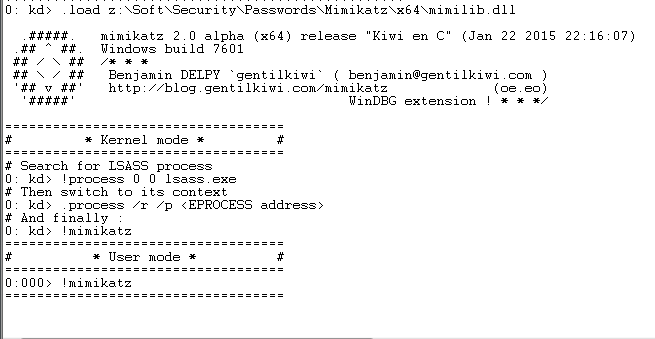
6. Находим адрес процесса lsass.exe.
0: kd> !process 0 0 lsass.exe

В данном случае адрес: fffffa800a7d9060.
7. Переключаем контекст процесса.
0: kd> .process /r /p fffffa800a7d9060

8. Запускаем mimikatz и получаем пароли в открытом виде.
0:kd> !mimikatz

Ссылки по теме
Раскрытие учетных данных в Microsoft Windows: http://www.securitylab.ru/vulnerability/420418.php
LSA Authentication: https://msdn.microsoft.com/en-us/library/windows/desktop/aa378326(v=vs.85).aspx
What is Digest Authentication: https://technet.microsoft.com/en-us/library/cc778868(WS.10).aspx
+72
Комментарии60
Windows Credential Manager view password is a helpful feature that allows you to view and delete any of your saved credentials for signing into websites, networks, and other connected applications. Additionally, it can help you manage your sensitive information by adding, removing, changing, backing up, or restoring information. So this article mainly talks about how to view saved password in it. Let’s dive in!
Part 1: How to View Saved Passwords in Windows Credential Manager?
- 1. Using Control Panel
- 2. Using CMD
- 3. Using Powershell
- 4. Windows Credential Manager Show Password Missing
Way 1. Using Control Panel
By proceeding in his guide, we will learn how to view password in credential manager windows 10.
The steps of using the control panel to access Credential Manager are as follows:
Step 1: To open Credential Manager, type credential in the search bar. You will see Credential Manager appearing in the search results. Click on it.
Step 2: Now, you will be able to see two results. i.e., Web Credentials or Windows Credentials. Details of these two are as follows:

Note:
- Web Credentials: These contain passwords that are saved using Internet Explorer or Microsoft Edge. If you use a different web browser, such as Chrome or Firefox, you will have to use the respective Credential Manager of that browser.
- Windows Credentials: This section is useful for those operating their PCs on corporate networks. All the passwords stored here are used for network-related windows services. People who are not corporate users will not be able to see any information in this section.
Step 3: After getting to the Credential Manager, click the arrow beside the account you want to view. It will display more information about that account, such as the option to look at the password. Furthermore, expanding the Windows Credentials section by clicking the Generic Credentials arrow will allow you to see all the saved-authentication tokens.
Step 4: In the Web Credentials windows, you can click the Show button next to the password you want to see. Before you see the password, a confirmation window will appear to authorize the action.

Step 5: Now, by entering your PIN or password, you can see your saved password appearing in the plaintext form.

Way 2. Using CMD
Windows passwords can be access easily by various way, and one of the most guru way to access them is using Command Prompt. Windows credential manager view password cmd is a few step technique to view the saved passwords in web/windows.
Step 1: First you need to press the window key and write command prompt.
Step 2: Now for Credential Manager to reveal the hidden user passwords to you, write the command rundll32.exe keymgr.dll, KRShowKeyMgr.
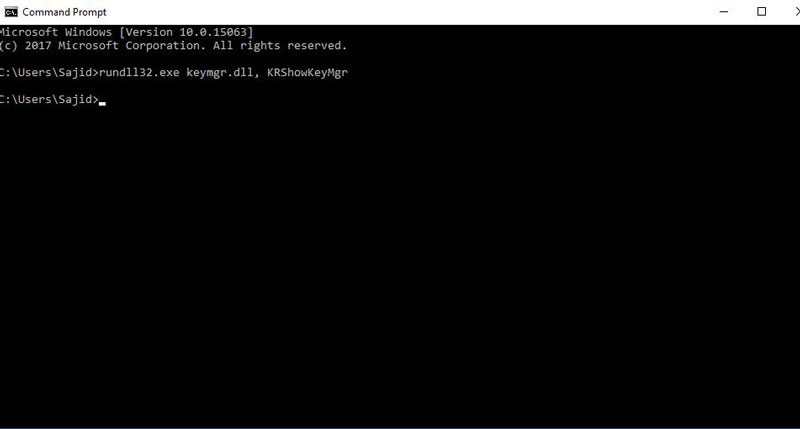
Step 3: Now press Enter.
Step 4: A new window will list all the login credentials and saved passwords in front of you, and you can click Add, Remove, Edit, buttons to modify, or save new login credentials.

Through the Windows Credential Manager command line, you can easily add, remove or edit files to your liking.
Way 3. Using Powershell
Using Powershell is one of the many ways to view windows passwords in credential manager. This method is quite simple, as you need the following three steps only:
Step 1: In Powershell5, type Install-Module CredentialManager -force.
Step 2: Now, type New-StoredCrdential -Target $url -Username $ENV:Username -Pass …..
Step 3: The final code that you are going to use in your Powershell will be Get-StoredCredential –Target.

Now at this point in the guide, we would like to point out that you might have come across various answers in your question for how to view saved passwords in windows credential manager. In this regard, one of the most promising solutions is using a windows password recovery software to help you discover your lost passwords.
Moreover, many people find it difficult to retrieve their saved passwords and username simply because they forget them. And since they cannot verify their identity, they are unable to login into their PCs. With products like windows recovery tools and windows credential manager you can regain access to your lost passwords, however, you can also reset or delete your passwords with them.
Way 4. Windows Credential Manager Show Password Missing
You may be unable to view the ‘windows 7 credential manager view password’ feature on your PC. To get rid of this problem, you can use your PC’s run box by following these steps:
Step 1: Press Windows and R keys together to open the Run box.
Step 2: In the box, type inetcpl.cpl and press Enter to open the Internet Properties.
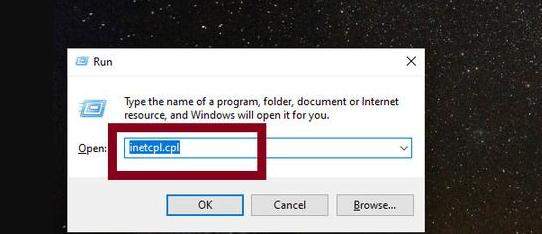
Step 3: Now, switch to the Content tab. Find and click Settings in the AutoComplete section.
Step 4: Clear all the checked boxes and proceed by clicking OK. Now, reselect entries again as they were before and click OK.
Step 5: Switch to the General tab in Internet Properties. There, click the Delete button. This action will prompt the opening of the Delete Browsing History window.
Step 6: In the Delete Browsing History window, select all the available options and click Delete to clear all the cache.
As an added measure, reboot your PC to implement these changes.
Part 2. How to Get Windows Password to Verify Identity?
As we have mentioned before, viewing the saved password and credentials on your PC requires you to know your PC’s password and username. This approach helps your PC to verify your identity and provides you access to the saved credentials. And if you can’t verify your identity on your PC for any given reason, you will not be able to view the saved passwords.
Thus, to get help in such situations, you can use UnlockGo – Windows Password Recovery. UnlockGo is the all-in-one tool for you if you are willing to verify your identity on your PC and also looking to reset Microsoft account password online and offline. This tool has some of the most advanced features to recover the passwords and usernames for locked Windows accounts.
UnlockGo (Windows) also helps you to recover your Microsoft account online, in the case if you loss the credentials to it, and won’t be able to recover it online.
UnlockGo (Windows)
- It only takes a single click to create a Windows password disk
- You can reset/remove passwords from all types of Windows accounts such aslocal, guest, admin, domain accounts
- You can even create and delete local/domain admin,guest account.
- All versions of Windows are supported
- All major PC brands are supported
How to Use UnlockGo – Windows Password to Verify Identity?
UnlockGo – Windows Password Recovery is an ultimate tool to help view windows passwords in credential manager. Downloading and using UnlockGo – Windows Password Recovery is very easy and requires only three steps:
Step 1 Get another PC and install UnlockGo – Windows Password Recovery. Prepare a blank bootable USB/CD/DVD, insert it into PC and start to burn.
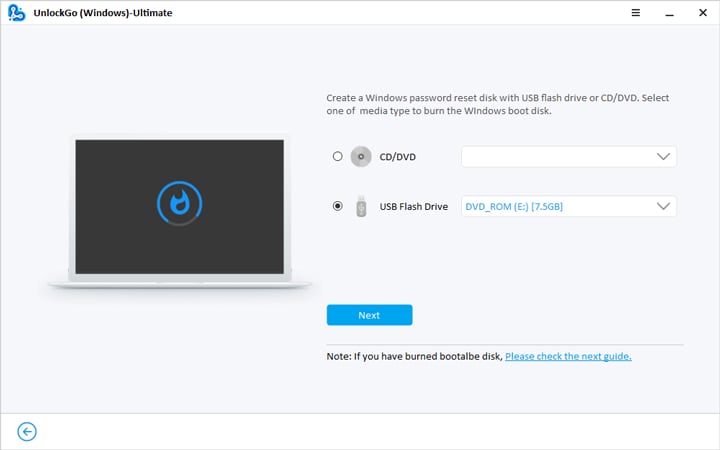
Step 2 On its main interface, you will come across different options to choose your password recovery media. Choose the one you like (in the form of a DVD, CD, or USB). Click Next.
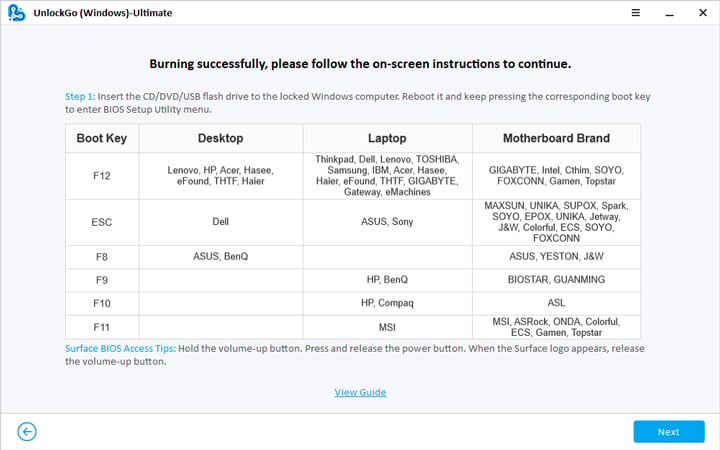
Step 3 The password recovery process will begin now and take some time to complete. After that you can reset/remove password or add a new user, or delete/edit any existing user as well easily.
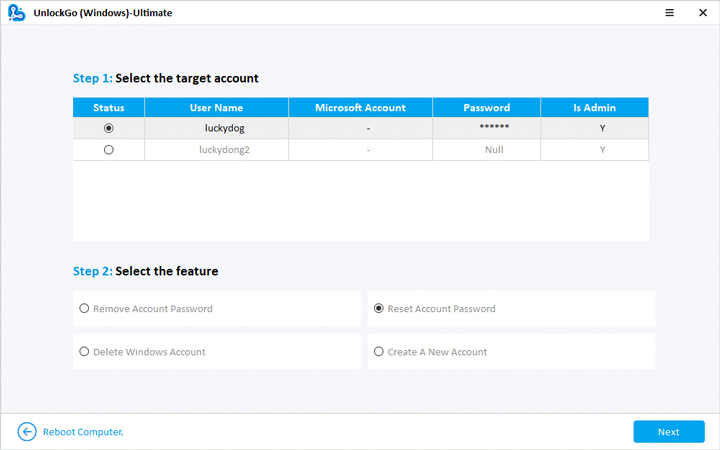
In a Nutshell
The basic purpose of writing this guide was to help you view windows passwords in credential manager. For this purpose, you can use different methods and imply different tricks, as mentioned in the guide below. And in case you fail to prove your identity to your PC and are unable to get access to your credential manager, then you can use UnlockGo – Windows Password Recovery.
How do I find saved passwords in Windows 10? A large number of programs and websites usually prompt its users’ to save their passwords for later use in their PCs and mobile phones. This gets usually stored on software like Instant Messenger, Windows Live Messengers and popular browsers like Google Chrome, Internet Explorer, Microsoft Edge, Mozilla Firefox, Opera (for both PCs and smart-phones) also provide this password saving feature. This password is usually stored in the secondary memory and can be retrieved even when the system is turned off. Specifically, these usernames, as well as their associated passwords, get stored in the registry, within the Windows Vault or within credential files. All such credentials get accumulated in an encrypted format, but can easily be decrypted just by entering your Windows password.
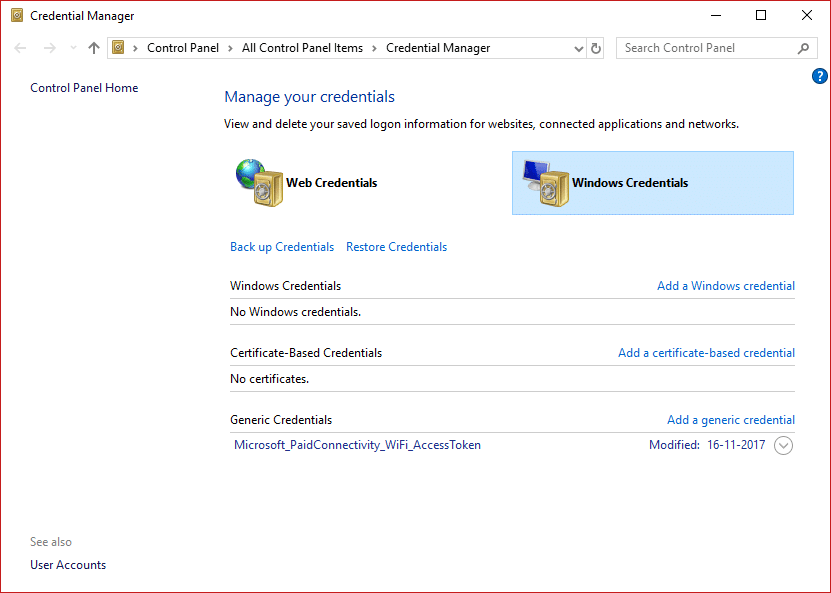
A frequent task that comes into play for all end-users is to uncover all the stored passwords on his/her computer. This eventually helps in recovering lost or forgotten access details to any specific online service or application. This is an easy task but depends on some of the aspects like the OS that the user is using or the application someone is using. In this article, we will show you different tools that can help you view different hidden encrypted passwords in your system.
Table of Contents
Method 1: Using Windows Credential Manager
Let us first get to know about this tool. It is a built-in Credential Manager of Windows that allows users to store their confidential username and passwords as well as other credentials that are entered in when a user logs on to any website or network. Storing these credentials in a manageable manner can help you automatically log you on to that site. This eventually reduces the time and effort of a user as they don’t have to type their login credentials every time they use this site. To see these usernames and passwords stored in the Windows Credential Manager, you have to go through the following steps –
1. Search for “Credential Manager” in the Start menu search box. Click on the search result to open.
Note: You’ll notice there are 2 categories: Web Credentials & Windows Credentials. Here your entire web credentials, as well as any passwords from sites which you saved during browsing using different browsers will be listed here.
2. Choose and Expand the link to see the password by clicking on the arrow button under the Web Passwords option and click on the “Show” button.

3. It will now prompt you to type your Windows password for decrypting the password and show it to you.
4. Again, when you click on Windows Credentials next to the Web Credentials, you will most likely see lesser credentials stored there unless you’re into a corporate environment. These are application and network-level credentials as and when you connect to network shares or network devices like the NAS.

Recommended: Reveal Hidden Passwords behind asterisk without any software
Method 2: Find Saved Passwords using Command Prompt
1. Press Windows Key + S to bring up search. Type cmd then right-click on Command Prompt and select Run as Administrator.
2. Now type the following command into cmd and hit Enter:
rundll32.exe keymgr.dll,KRShowKeyMgr
3. Once you hit Enter, stored Usernames and Passwords window will open.

4. You can now add, remove or edit the stored passwords.
Method 3: Using third-party tools
There are other 3rd party tools available that will help you view your passwords stored in your system. These are:
a) CredentialsFileView
1. Once downloaded, right-click on the “CredentialsFileView” application and choose Run as Administrator.
2. You will see the main dialog which will pop up. You will have to type in your Windows password at the bottom side and then press “OK”.
Note: Now it will be possible for you to see the list of different credentials stored on your computer. If you are on a domain, you will also see a lot more data in the form of a database having Filename, version modified time etc.

b) VaultPasswordView
This has the same functionality as that of CredentialsFileView, but it will look inside the Windows Vault. This tool is essential particularly for Windows 8 & Windows 10 users as these 2 OS stores the passwords of different apps like Windows Mail, IE, and MS. Edge, in the Windows Vault.

c) EncryptedRegView
1. Run this program, a new dialog box will pop up where the ‘Run as administrator’ box will be checked, press the “OK” button.
2. The tool will automatically scan the registry & decrypt your existing passwords it will fetch from the registry.

Also read: How to Create a Password Reset Disk
Using any of the three methods you will be able to view or find the saved passwords on Windows 10, but if you still have questions or doubts regarding this tutorial then feel free to ask them in the comment section.

